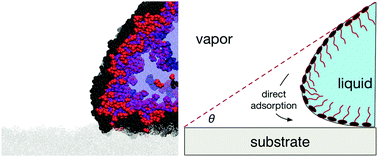Smoothing of contact lines in spreading droplets by trisiloxane surfactants and its relevance for superspreading†
Abstract
Superspreading, the greatly enhanced spreading of aqueous solutions of trisiloxane surfactants on hydrophobic substrates, is of great interest in fundamental physics and technical applications. Despite numerous studies in the last 20 years, the superspreading mechanism is still not well understood, largely because the molecular scale cannot be resolved appropriately either experimentally or using continuum simulations. The absence of molecular-scale knowledge has led to a series of conflicting hypotheses based on different assumptions of surfactant behavior. We report a series of large-scale molecular dynamics simulations of aqueous solutions of superspreading and non-superspreading surfactants on different substrates. We find that the transition from the liquid–vapor to the solid–liquid interface is smooth for superspreading conditions, allowing direct adsorption through the contact line. This finding complements a study [Karapetsas et al., J. Fluid Mech., 2011, 670, 5–37], which predicts that superspreading can occur if this adsorption path is possible. Based on the observed mechanism, we provide plausible explanations for the influence of the substrate hydrophobicity, the surfactant chain length, and the surfactant concentration on the superspreading phenomenon. We also briefly address that the observed droplet shape is a mechanism to overcome the Huh–Scriven paradox of infinite viscous dissipation at the contact line.



 Please wait while we load your content...
Please wait while we load your content...